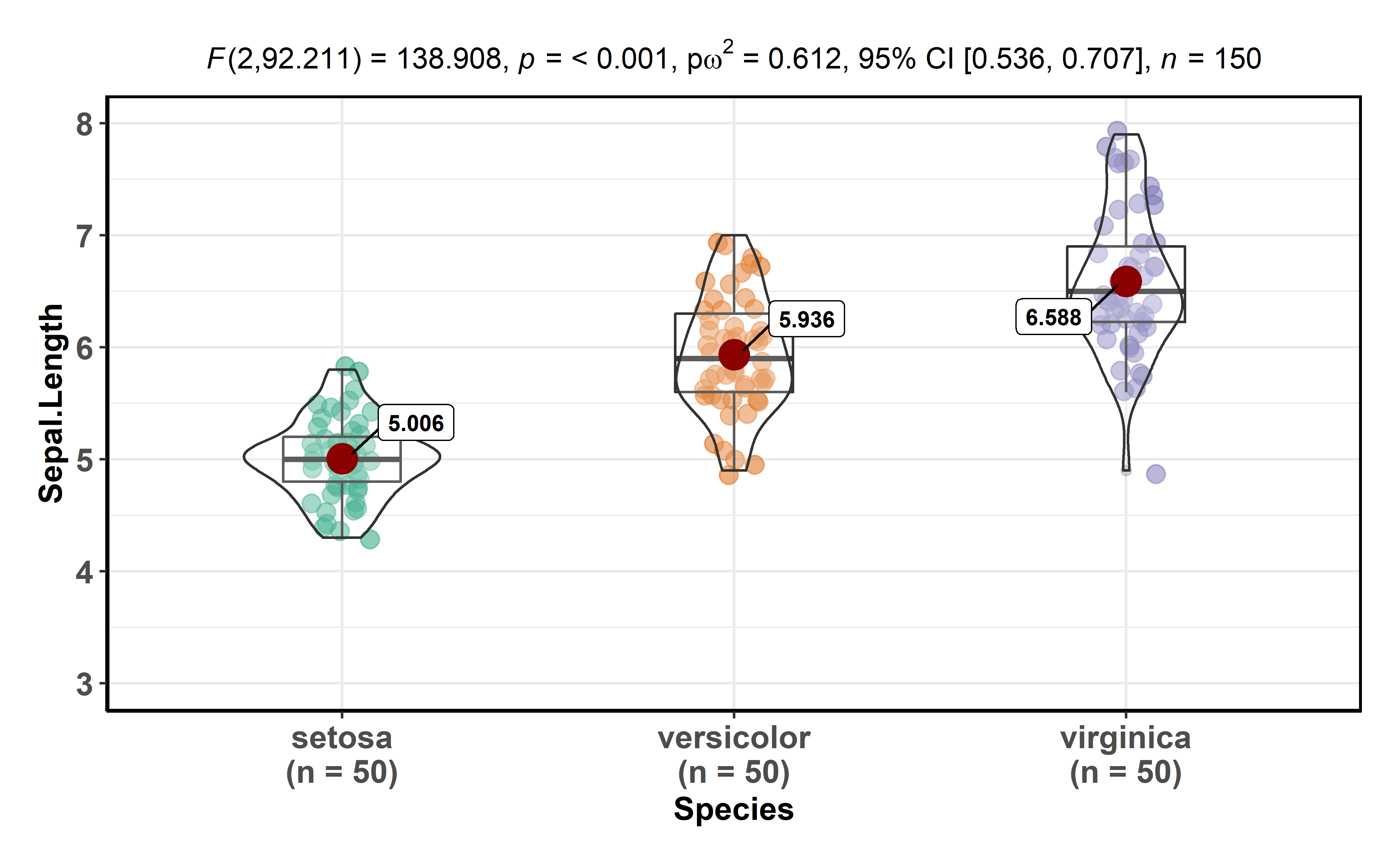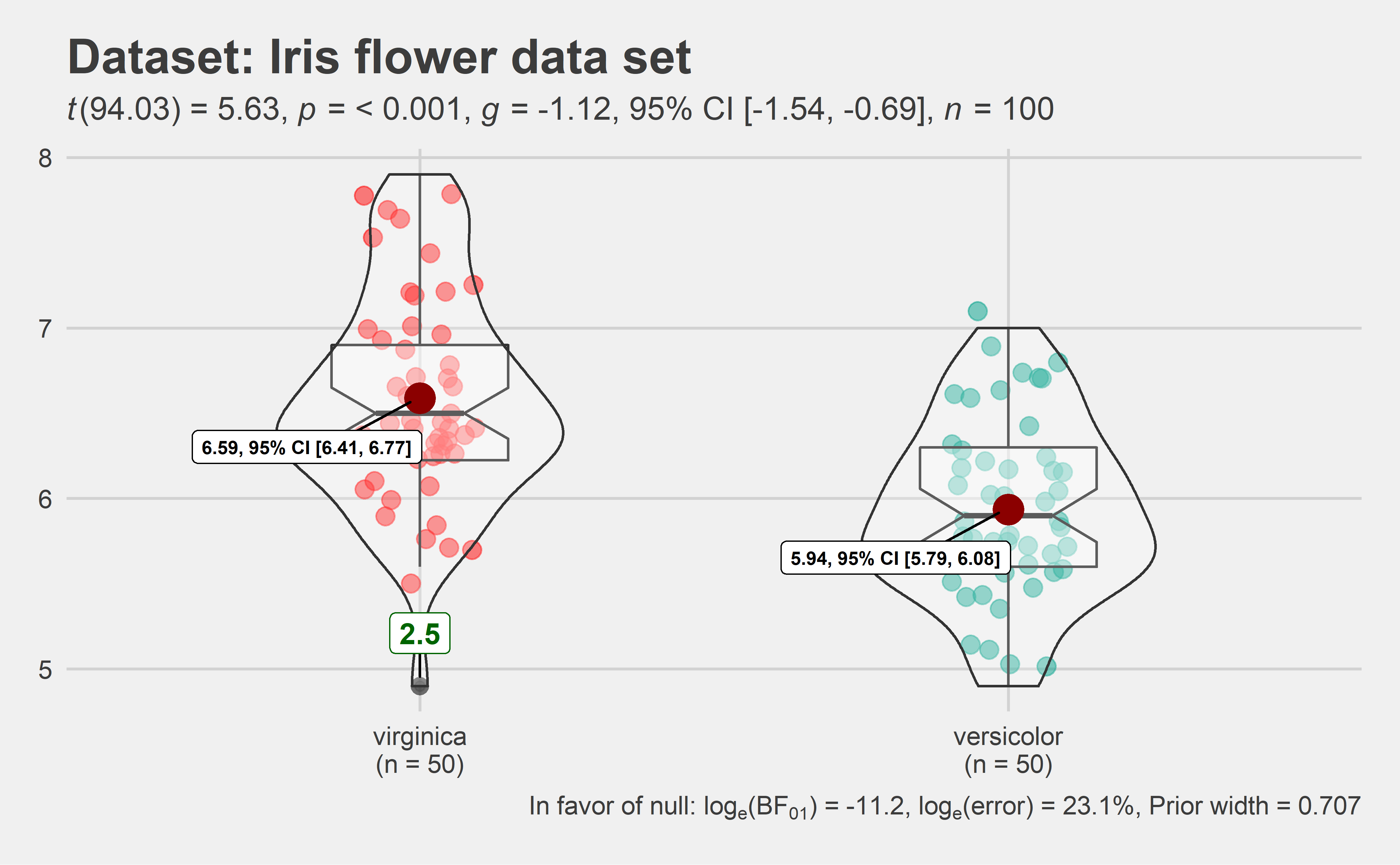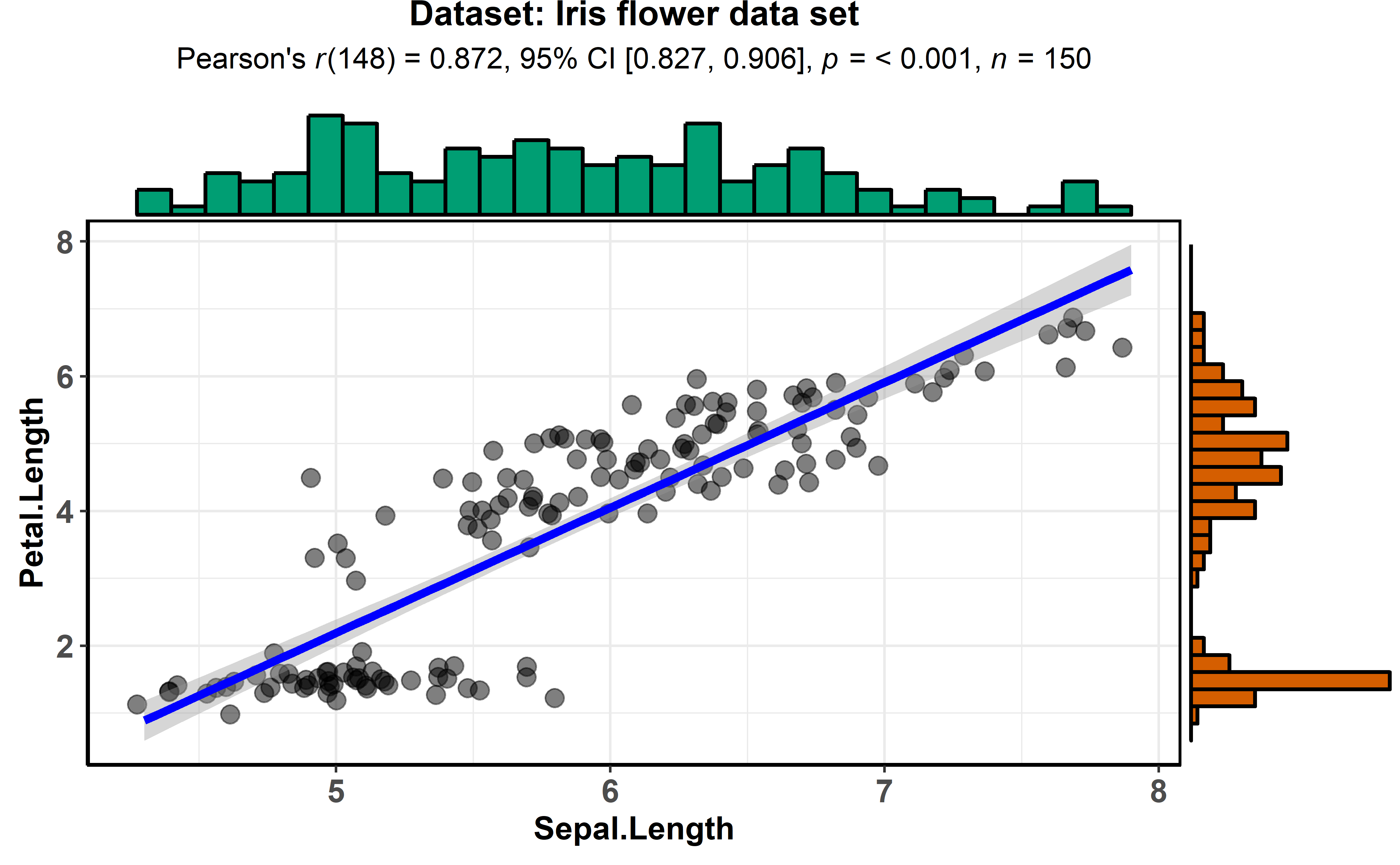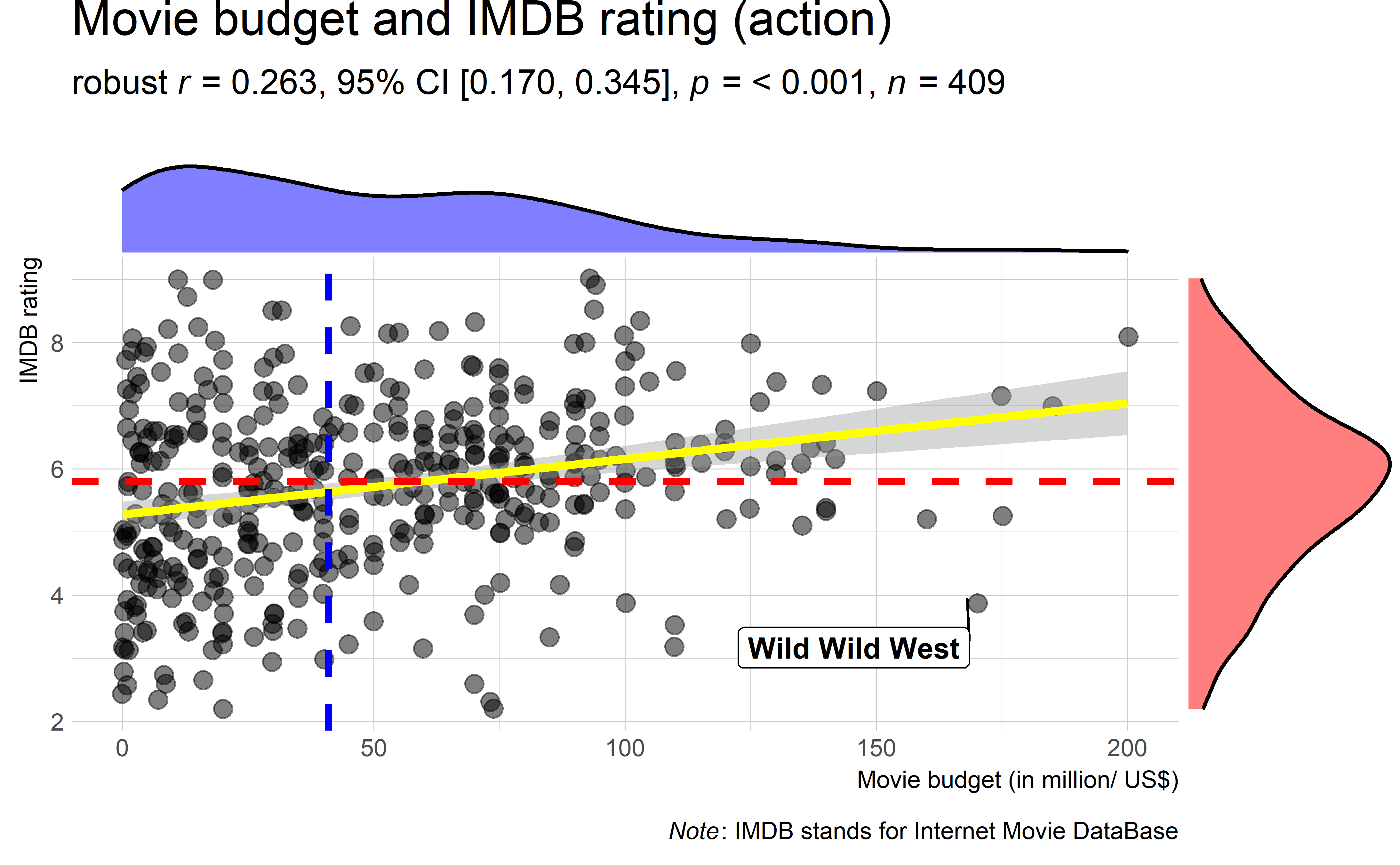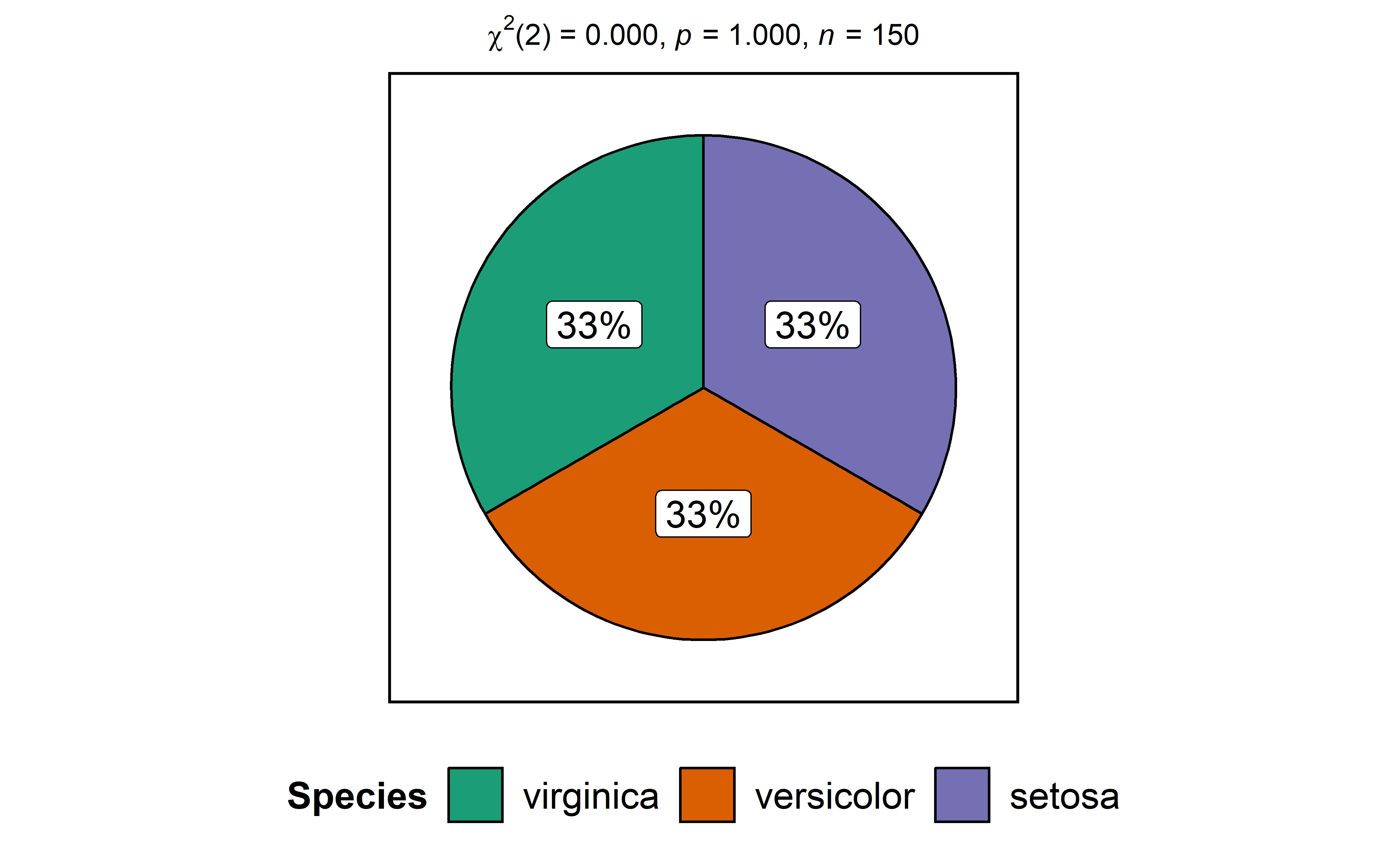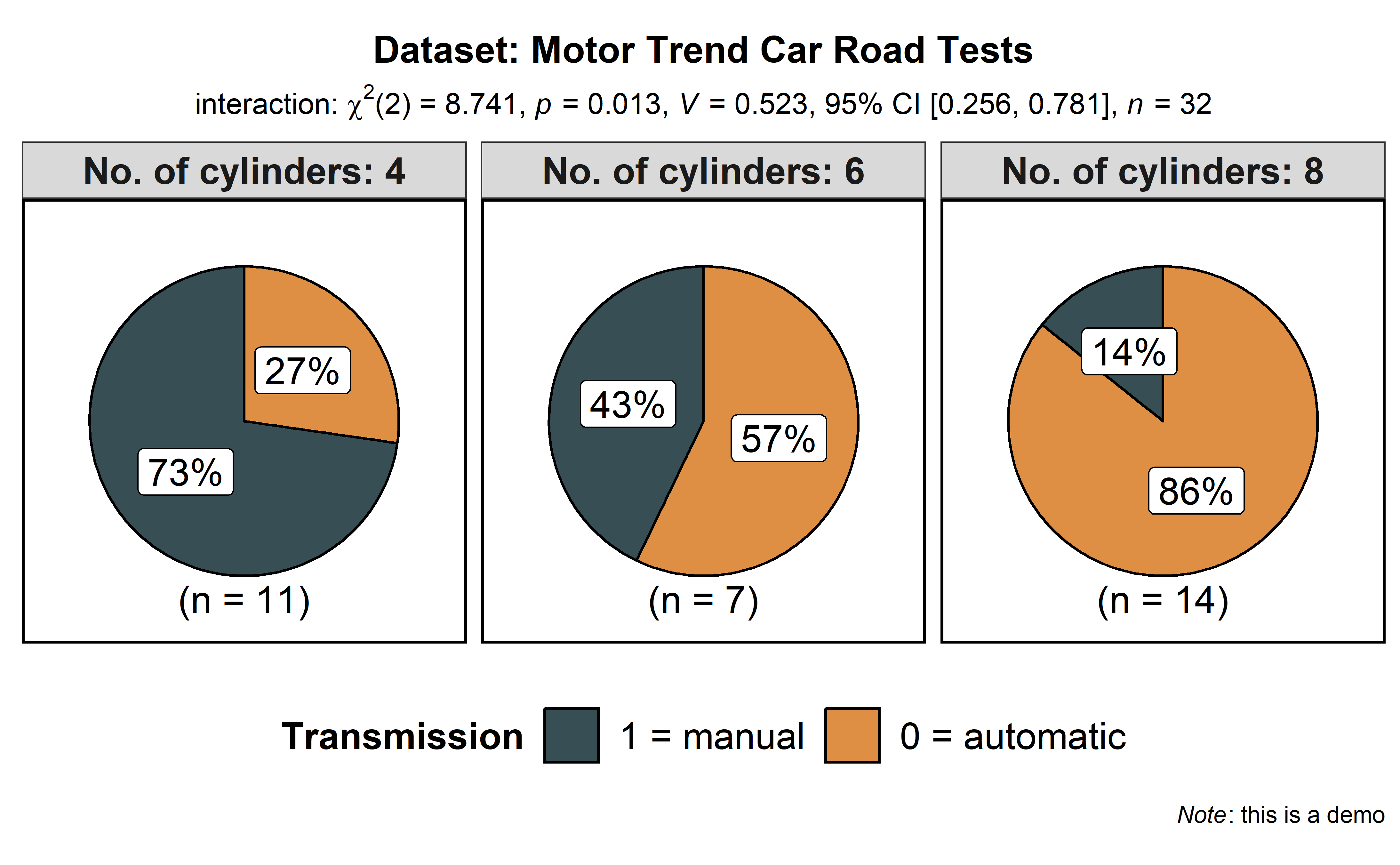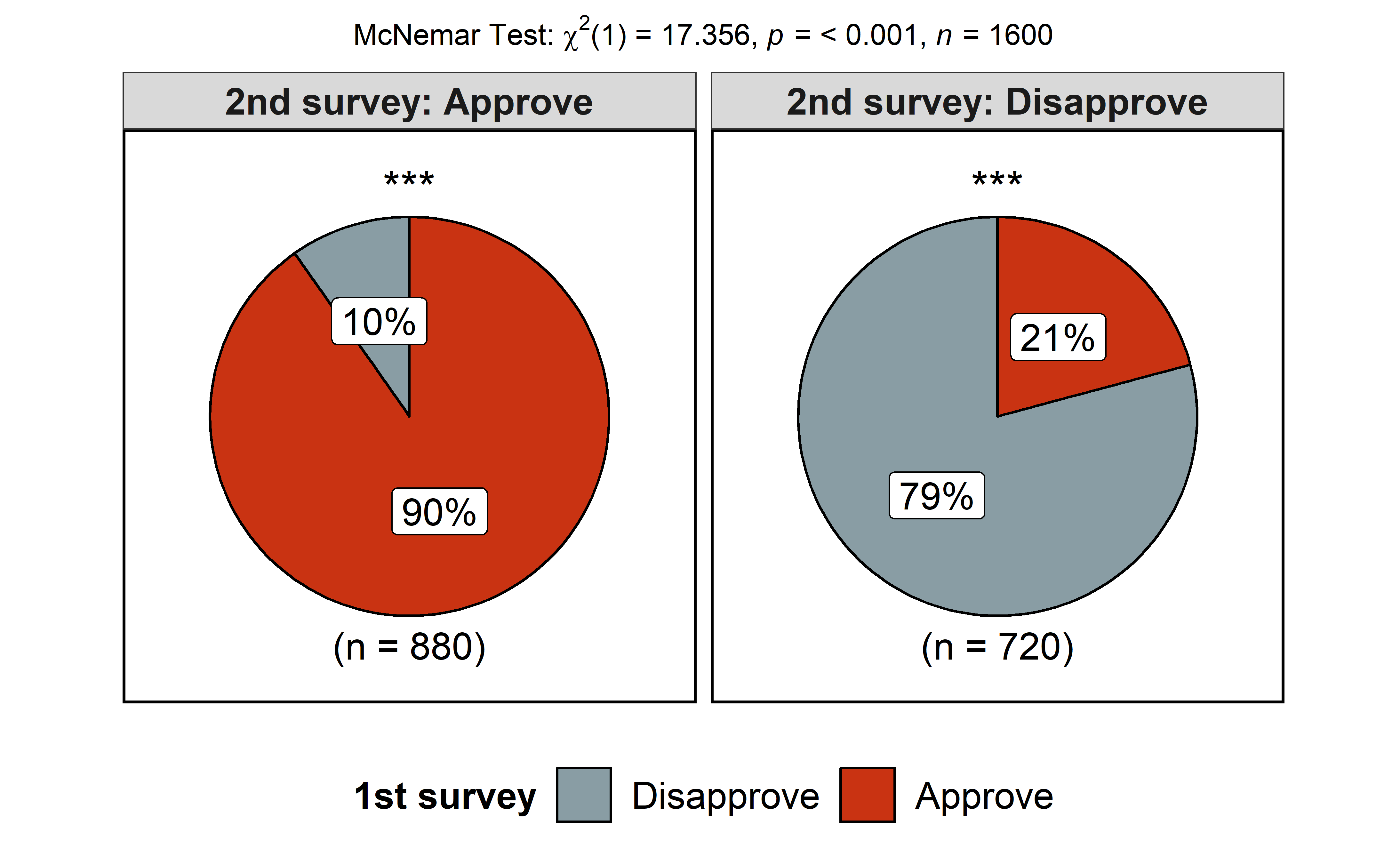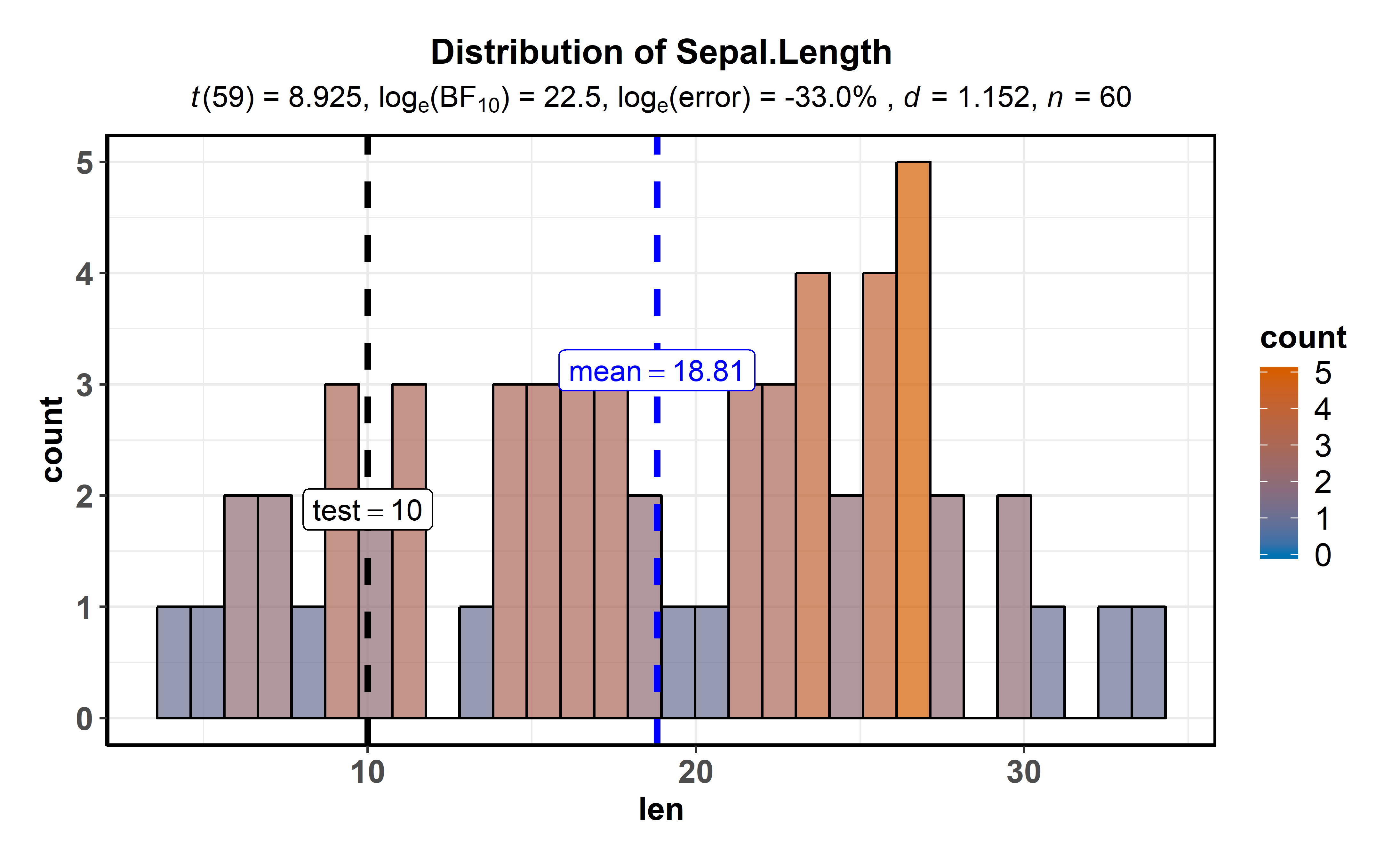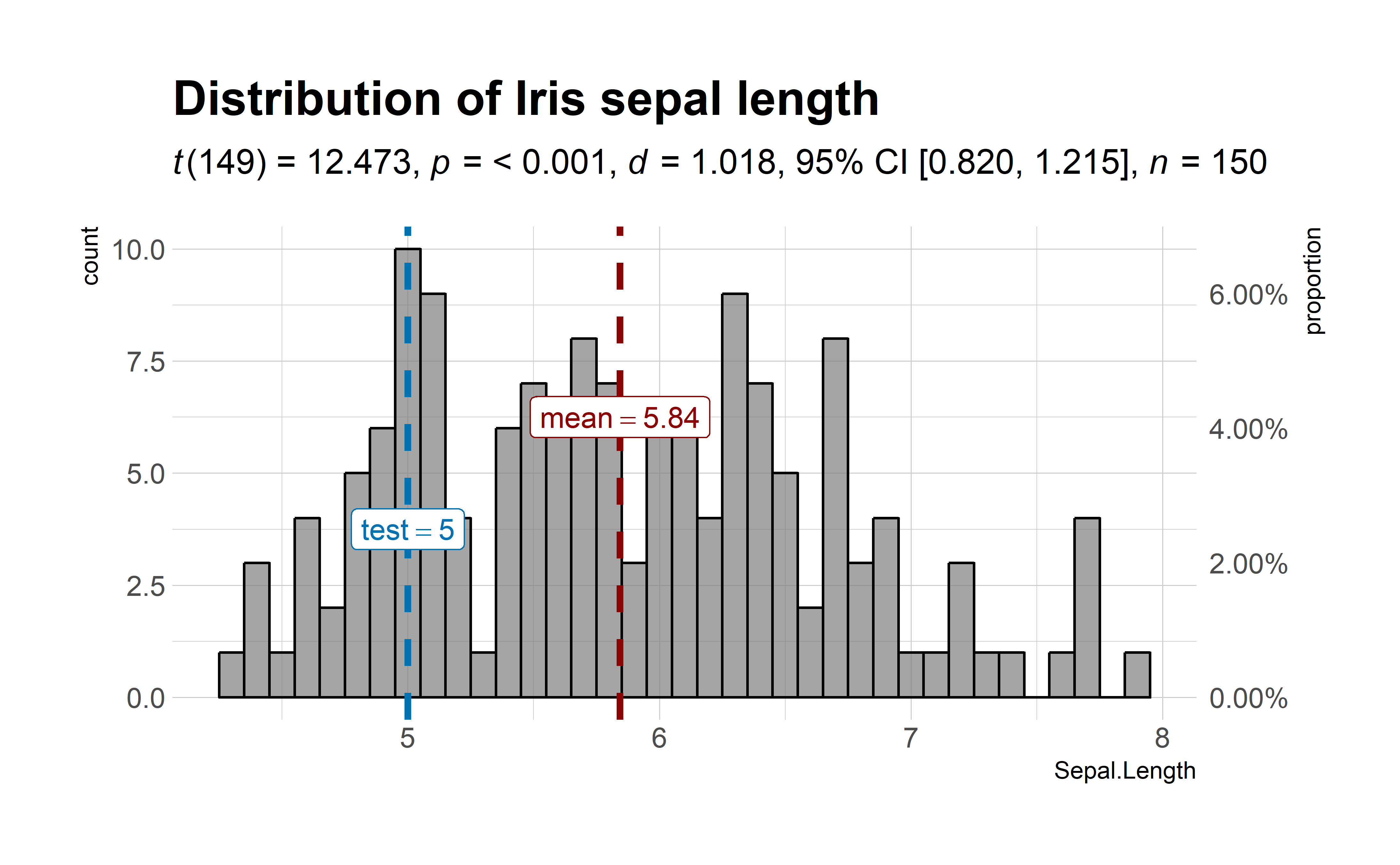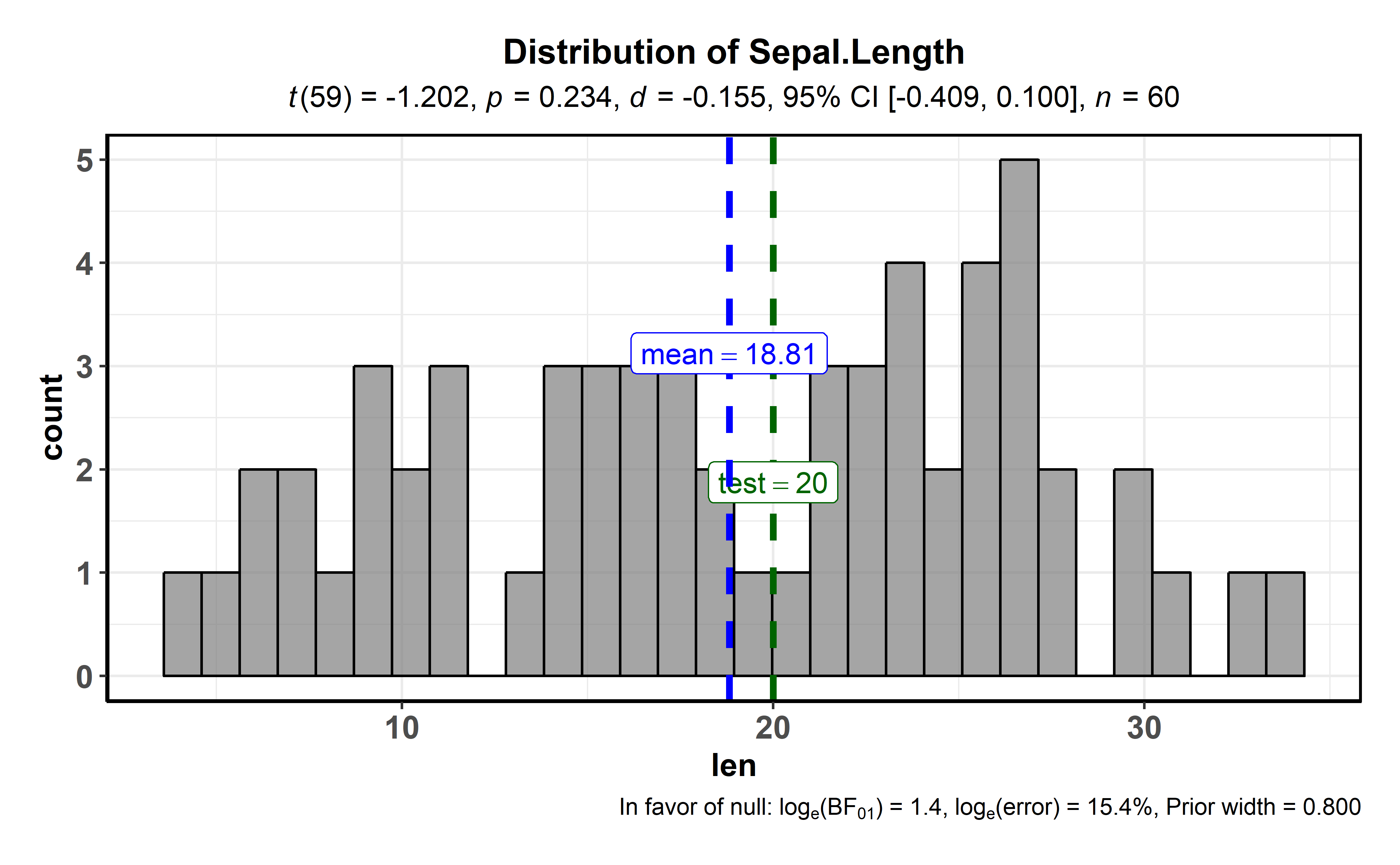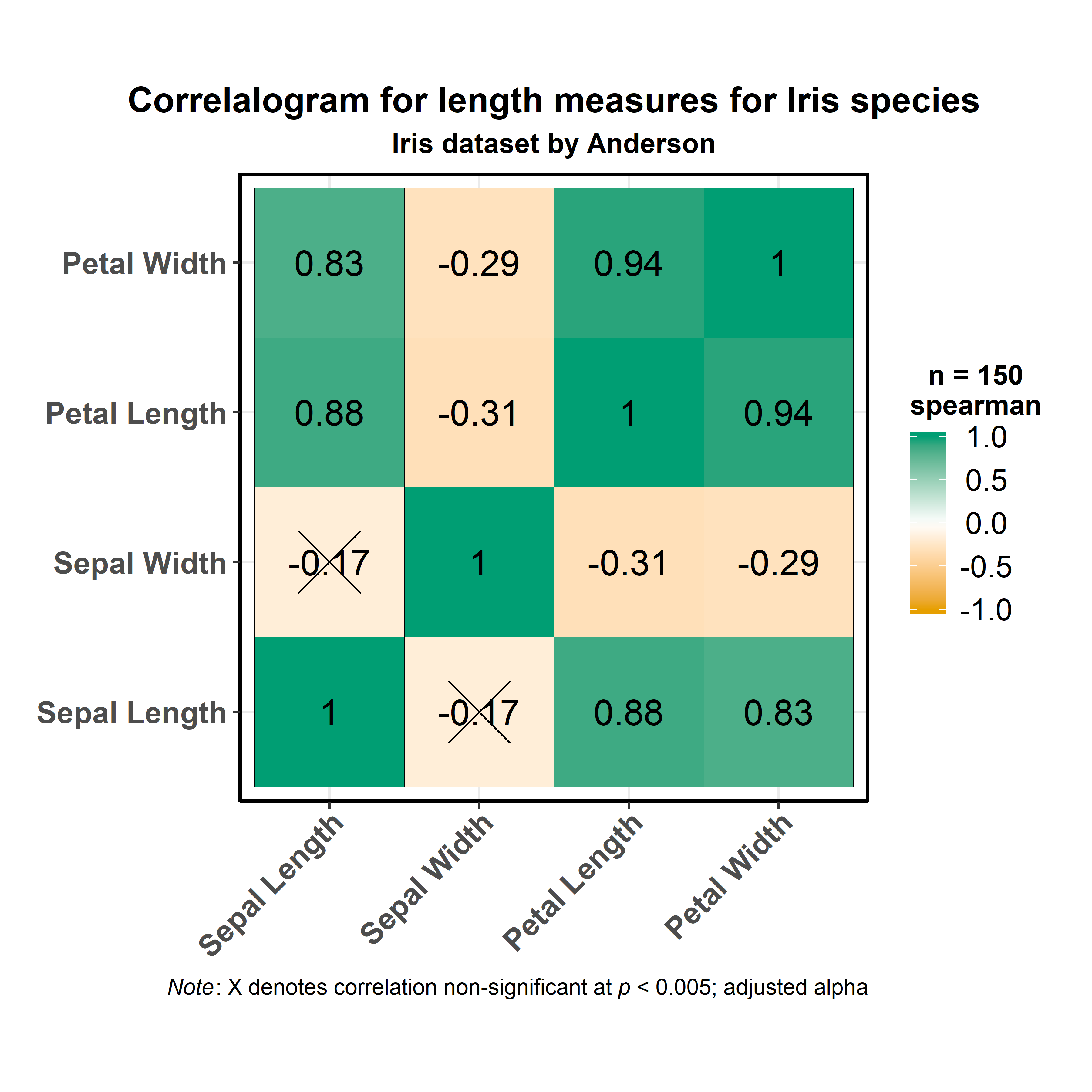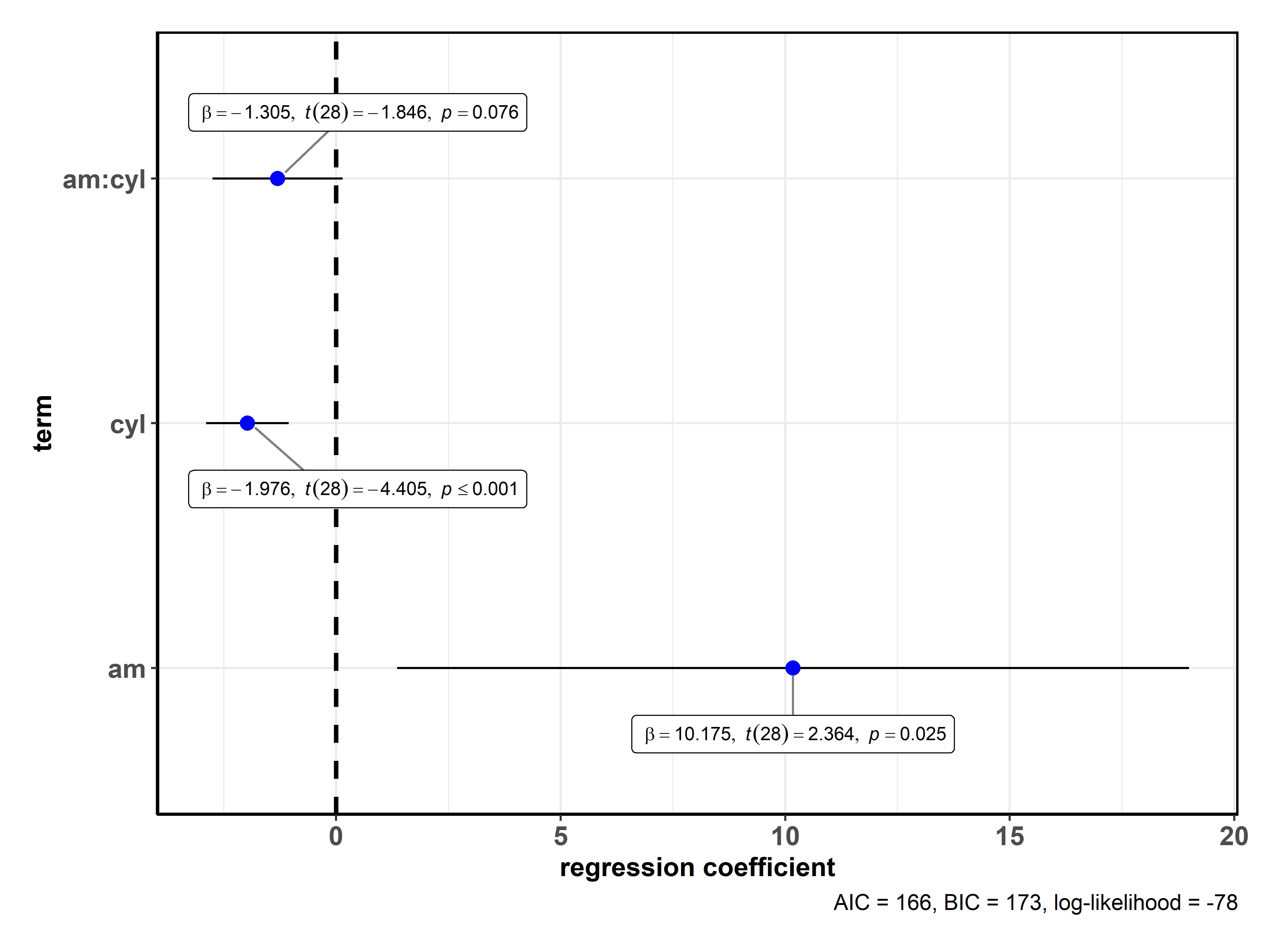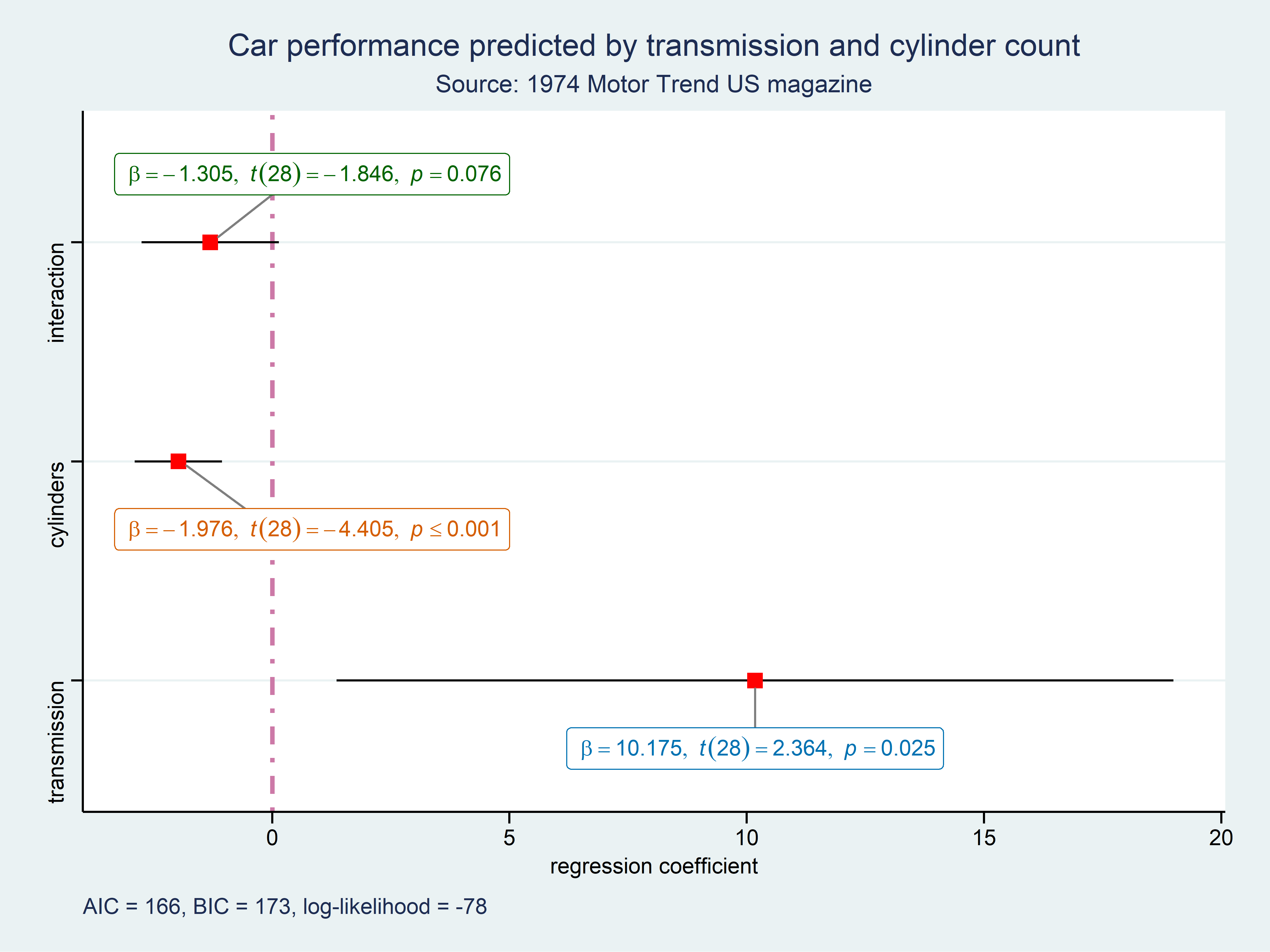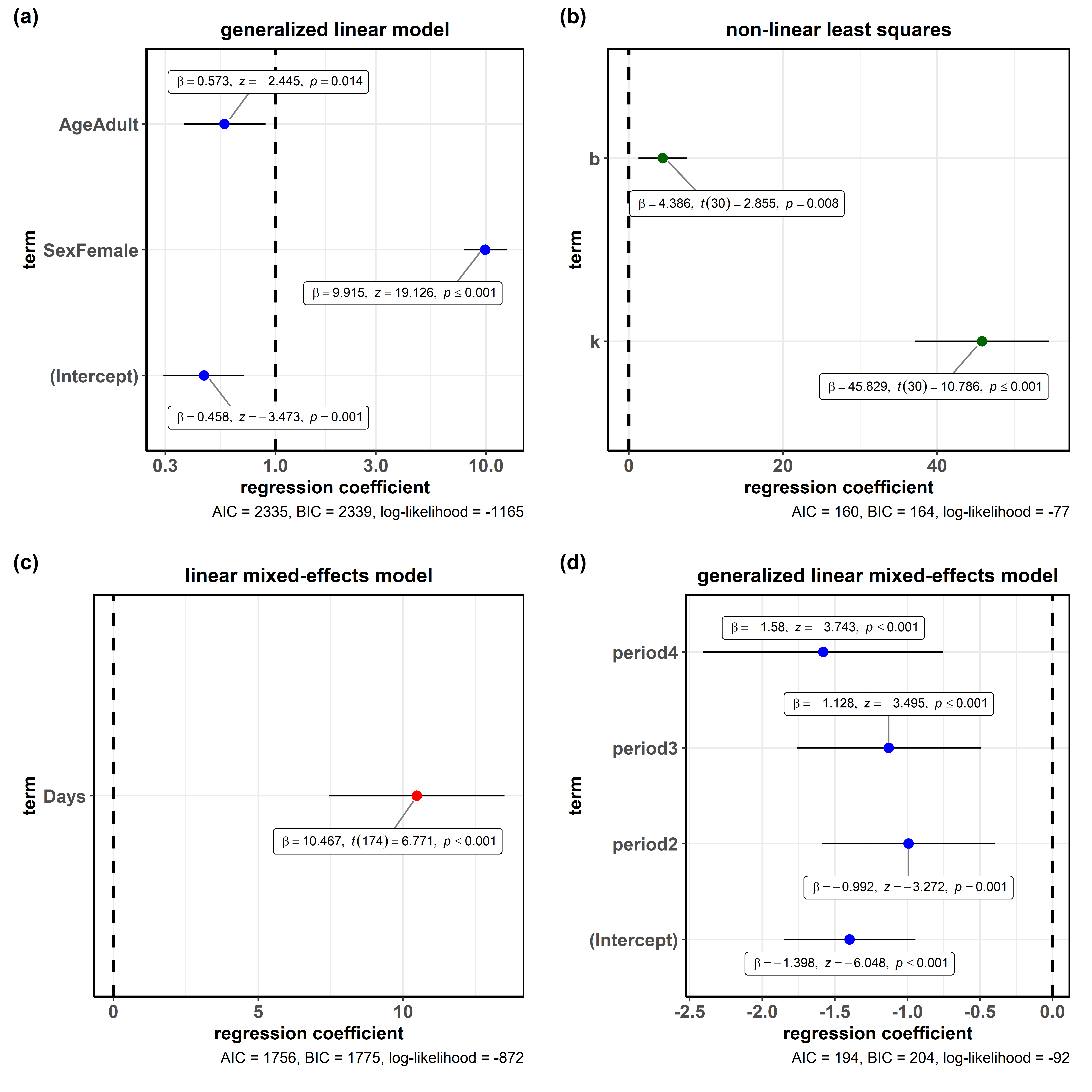ggstatsplot is an
extension of ggplot2 package
for creating graphics with details from statistical tests included in
the plots themselves and targeted primarily at behavioral sciences
community to provide a one-line code to produce information-rich plots.
Currently, it supports only the most common types of statistical tests
(parametric, nonparametric, and robust versions of
t-tets/anova, correlation, and contingency tables analyses).
It, therefore, produces a limited kinds of plots for the supported analyses:
- violin plots (for comparisons between groups or conditions),
- pie charts (for categorical data),
- scatterplots (for correlations between two variables),
- correlation matrices (for correlations between multiple variables),
- histograms (for hypothesis about distributions), and
- dot-and-whisker plots (for regression models).
In addition to these basic plots, ggstatsplot also provides
grouped_ versions of all functions that makes it easy to repeat
the same anlysis for any grouping variable.
Future versions will include other types of statistical analyses and plots as well.
To get the latest, stable CRAN release (0.0.5):
utils::install.packages(pkgs = "ggstatsplot")You can get the development version of the package from GitHub
(0.0.5.9000). To see what new changes (and bug fixes) have been made
to the package since the last release on CRAN, you can check the
detailed log of changes here:
https://indrajeetpatil.github.io/ggstatsplot/news/index.html
If you are in hurry and want to reduce the time of installation, prefer-
# needed package to download from GitHub repo
utils::install.packages(pkgs = "devtools")
# downloading the package from GitHub
devtools::install_github(
repo = "IndrajeetPatil/ggstatsplot", # package path on GitHub
dependencies = FALSE, # assumes that you already have all packages installed needed for this package to work
quick = TRUE # skips docs, demos, and vignettes
) If time is not a constraint-
devtools::install_github(
repo = "IndrajeetPatil/ggstatsplot", # package path on GitHub
dependencies = TRUE, # installs packages which ggstatsplot depends on
upgrade_dependencies = TRUE # updates any out of date dependencies
)If you are not using the RStudio IDE and you
get an error related to “pandoc” you will either need to remove the
argument build_vignettes = TRUE (to avoid building the vignettes) or
install pandoc. If you have the rmarkdown R
package installed then you can check if you have pandoc by running the
following in R:
rmarkdown::pandoc_available()
#> [1] TRUEIf you want to cite this package in a scientific journal or in any other
context, run the following code in your R console:
utils::citation(package = "ggstatsplot")There is currently a publication in preparation corresponding this package and the citation will be updated once it’s published.
There is a dedicated website to ggstatplot, which is updated after
every new commit: https://indrajeetpatil.github.io/ggstatsplot/.
In R, documentation for any function can be accessed with the standard
help command-
# primary functions
?ggbetweenstats
?ggscatterstats
?gghistostats
?ggpiestats
?ggcorrmat
?ggcoefstats
# grouped variants of primary functions
?grouped_ggbetweenstats
?grouped_ggscatterstats
?grouped_gghistostats
?grouped_ggpiestats
?grouped_ggcorrmat
# helper functions
?combine_plots
?theme_ggstatsplotAnother handy tool to see arguments to any of the functions is args.
For example-
args(name = ggstatsplot::ggscatterstats)
#> function (data, x, y, label.var = NULL, label.expression = NULL,
#> xlab = NULL, ylab = NULL, method = "lm", method.args = list(),
#> formula = y ~ x, line.size = 1.5, line.color = "blue", marginal = TRUE,
#> marginal.type = "histogram", marginal.size = 5, margins = c("both",
#> "x", "y"), width.jitter = NULL, height.jitter = NULL,
#> xfill = "#009E73", yfill = "#D55E00", xalpha = 1, yalpha = 1,
#> xsize = 0.7, ysize = 0.7, centrality.para = NULL, type = "pearson",
#> results.subtitle = TRUE, title = NULL, subtitle = NULL, caption = NULL,
#> nboot = 100, beta = 0.1, k = 3, axes.range.restrict = FALSE,
#> ggtheme = ggplot2::theme_bw(), ggstatsplot.layer = TRUE,
#> messages = TRUE)
#> NULLIn case you want to look at the function body for any of the functions, just type the name of the function without the paranetheses:
ggstatsplot::theme_ggstatsplot
#> function(ggtheme = ggplot2::theme_bw(), ggstatsplot.layer = TRUE) {
#> if (isTRUE(ggstatsplot.layer)) {
#> ggtheme +
#> ggplot2::theme(
#> axis.title.x = ggplot2::element_text(size = 12, face = "bold"),
#> strip.text.x = ggplot2::element_text(size = 12, face = "bold"),
#> strip.text.y = ggplot2::element_text(size = 12, face = "bold"),
#> strip.text = ggplot2::element_text(size = 12, face = "bold"),
#> axis.title.y = ggplot2::element_text(size = 12, face = "bold"),
#> axis.text.x = ggplot2::element_text(size = 12, face = "bold"),
#> axis.text.y = ggplot2::element_text(size = 12, face = "bold"),
#> axis.line = ggplot2::element_line(),
#> legend.text = ggplot2::element_text(size = 12),
#> legend.title = ggplot2::element_text(size = 12, face = "bold"),
#> legend.title.align = 0.5,
#> legend.text.align = 0.5,
#> legend.key.height = grid::unit(x = 1, units = "line"),
#> legend.key.width = grid::unit(x = 1, units = "line"),
#> plot.margin = grid::unit(x = c(1, 1, 1, 1), units = "lines"),
#> panel.border = ggplot2::element_rect(
#> color = "black",
#> fill = NA,
#> size = 1
#> ),
#> plot.title = ggplot2::element_text(
#> color = "black",
#> size = 13,
#> face = "bold",
#> hjust = 0.5
#> ),
#> plot.subtitle = ggplot2::element_text(
#> color = "black",
#> size = 11,
#> face = "bold",
#> hjust = 0.5
#> )
#> )
#> } else {
#> ggtheme
#> }
#> }
#> <bytecode: 0x000000002abf1a78>
#> <environment: namespace:ggstatsplot>If you are not familiar either with what the namespace :: does or how
to use pipe operator %>%, something this package and its documentation
relies a lot on, you can check out these links-
ggstatsplot relies on non-standard
evaluation,
which means you shouldn’t enter arguments in the following manner:
data = NULL, x = data$x, y = data$y. You must always specify the
data argument for all functions.
Additionally, ggstatsplot is a very chatty package and will by default
output information about references for tests, notes on assumptions
about linear models, and warnings. If you don’t want your console to be
cluttered with such messages, they can be turned off by setting argument
messages = FALSE in the function call.
Here are examples of the main functions currently supported in
ggstatsplot.
Note: The documentation below is for the development version of the package. So you may see some features available here that are not currently present in the stable version of this package on CRAN. For documentation relevant for the CRAN version, see the vignettes on the site: https://cran.r-project.org/web/packages/ggstatsplot/vignettes/
This function creates either a violin plot, a box plot, or a mix of two for between-group or between-condition comparisons with results from statistical tests in the subtitle. The simplest function call looks like this-
# for reproducibility
set.seed(123)
# plot
ggstatsplot::ggbetweenstats(
data = datasets::iris,
x = Species,
y = Sepal.Length,
messages = FALSE
) + # further modification outside of ggstatsplot
ggplot2::coord_cartesian(ylim = c(3, 8)) +
ggplot2::scale_y_continuous(breaks = seq(3, 8, by = 1))
#> Note: 95% CI for partial omega-squared was computed with 100 bootstrap samples.Note that this function returns a ggplot2 object and thus any of the
graphics layers can be further modified.
The type (of test) argument also accepts the following abbreviations:
"p" (for parametric) or "np" (for nonparametric) or "r" (for
robust) or "bf" (for Bayes Factor). Additionally, the type of plot
to be displayed can also be modified ("box", "violin", or
"boxviolin").
A number of other arguments can be specified to make this plot even more informative or change some of the default options.
library(ggplot2)
# for reproducibility
set.seed(123)
# let's leave out one of the factor levels and see if instead of anova, a t-test will be run
iris2 <- dplyr::filter(.data = datasets::iris, Species != "setosa")
# let's change the levels of our factors, a common routine in data analysis
# pipeline, to see if this function respects the new factor levels
iris2$Species <-
base::factor(x = iris2$Species,
levels = c("virginica" , "versicolor"))
# plot
ggstatsplot::ggbetweenstats(
data = iris2,
x = Species,
y = Sepal.Length,
notch = TRUE, # show notched box plot
mean.plotting = TRUE, # whether mean for each group is to be displayed
mean.ci = TRUE, # whether to display confidence interval for means
mean.label.size = 2.5, # size of the label for mean
type = "p", # which type of test is to be run
bf.message = TRUE, # add a message with bayes factor in favor of the null
k = 2, # number of decimal places for statistical results
outlier.tagging = TRUE, # whether outliers need to be tagged
outlier.label = Sepal.Width, # variable to be used for the outlier tag
outlier.label.color = "darkgreen", # changing the color for the text label
xlab = "Type of Species", # label for the x-axis variable
ylab = "Attribute: Sepal Length", # label for the y-axis variable
title = "Dataset: Iris flower data set", # title text for the plot
ggtheme = ggthemes::theme_fivethirtyeight(), # choosing a different theme
ggstatsplot.layer = FALSE, # turn off ggstatsplot theme layer
package = "wesanderson", # package from which color palette is to be taken
palette = "Darjeeling1", # choosing a different color palette
messages = FALSE
) In case of a parametric t-test, setting bf.message = TRUE will also
attach results from Bayesian Student’s t-test. That way, if the null
hypothesis can’t be rejected with the NHST approach, the Bayesian
approach can help index evidence in favor of the null hypothesis (i.e.,
BF01).
By default, Bayes Factor quantifies the support for the alternative
hypothesis (H1) over the null hypothesis (H0) (i.e., BF10 is
displayed). Natural logarithms are shown because BF values can be pretty
large. This also makes it easy to compare evidence in favor alternative
(BF10) versus null (BF01) hypotheses (since log(BF10) = - log(BF01)).
For more, see the ggbetweenstats vignette:
https://indrajeetpatil.github.io/ggstatsplot/articles/ggbetweenstats.html
** This function is not appropriate for within-subjects designs.**
Variant of this function ggwithinstats is currently under work. You
can still use this function just to prepare the plot for
exploratory data analysis, but the statistical details displayed in the
subtitle will be incorrect. You can remove them by adding + ggplot2::labs(subtitle = NULL).
This function creates a scatterplot with marginal
histograms/boxplots/density/violin/densigram plots from
ggExtra::ggMarginal and results from statistical tests in the
subtitle:
ggstatsplot::ggscatterstats(
data = datasets::iris,
x = Sepal.Length,
y = Petal.Length,
title = "Dataset: Iris flower data set",
messages = FALSE
)
#> Warning: The plot is not a `ggplot` object and therefore can't be further modified with `ggplot2` functions.Number of other arguments can be specified to modify this basic plot-
library(datasets)
# for reproducibility
set.seed(123)
# plot
ggstatsplot::ggscatterstats(
data = dplyr::filter(.data = ggstatsplot::movies_long, genre == "Action"),
x = budget,
y = rating,
type = "robust", # type of test that needs to be run
xlab = "Movie budget (in million/ US$)", # label for x axis
ylab = "IMDB rating", # label for y axis
label.var = title, # variable for labeling data points
label.expression = rating < 5 & budget > 150, # expression that decides which points to label
line.color = "yellow", # changing regression line color line
title = "Movie budget and IMDB rating (action)",# title text for the plot
caption = expression( # caption text for the plot
paste(italic("Note"), ": IMDB stands for Internet Movie DataBase")
),
ggtheme = hrbrthemes::theme_ipsum_ps(), # choosing a different theme
ggstatsplot.layer = FALSE, # turn off ggstatsplot theme layer
marginal.type = "density", # type of marginal distribution to be displayed
xfill = "blue", # color fill for x-axis marginal distribution
yfill = "red", # color fill for y-axis marginal distribution
xalpha = 0.5, # transparency for x-axis marginal distribution
yalpha = 0.5, # transparency for y-axis marginal distribution
centrality.para = "median", # which type of central tendency lines are to be displayed
width.jitter = 0.2, # amount of horizontal jitter for data points
height.jitter = 0.4, # amount of vertical jitter for data points
messages = FALSE # turn off messages and notes
)
#> Warning: The plot is not a `ggplot` object and therefore can't be further modified with `ggplot2` functions.For more, see the ggscatterstats vignette:
https://indrajeetpatil.github.io/ggstatsplot/articles/ggscatterstats.html
This function creates a pie chart for categorical or nominal variables with results from contingency table analysis (Pearson’s chi-squared test for between-subjects design and McNemar’s test for within-subjects design) included in the subtitle of the plot. If only one categorical variable is entered, results from one-sample proportion test will be displayed as a subtitle.
# for reproducibility
set.seed(123)
# plot
ggstatsplot::ggpiestats(
data = datasets::iris,
main = Species,
messages = FALSE
)This function can also be used to study an interaction between two
categorical variables. Additionally, this basic plot can further be
modified with additional arguments and the function returns a ggplot2
object that can further be modified with ggplot2 syntax:
# for reproducibility
set.seed(123)
# plot
ggstatsplot::ggpiestats(
data = datasets::mtcars,
main = am,
condition = cyl,
title = "Dataset: Motor Trend Car Road Tests", # title for the plot
stat.title = "interaction: ", # title for the results from Pearson's chi-squared test
legend.title = "Transmission", # title for the legend
factor.levels = c("1 = manual", "0 = automatic"), # renaming the factor level names for 'main' variable
facet.wrap.name = "No. of cylinders", # name for the facetting variable
facet.proptest = FALSE, # turning of facetted proportion test results
package = "ggsci", # package from which color palette is to be taken
palette = "default_jama", # choosing a different color palette
caption = expression( # text for the caption
paste(italic("Note"), ": this is a demo")
),
messages = FALSE # turn off messages and notes
) In case of within-subjects designs, setting paired = TRUE will produce
results from McNemar test-
# for reproducibility
set.seed(123)
# data
survey.data <- data.frame(
`1st survey` = c('Approve', 'Approve', 'Disapprove', 'Disapprove'),
`2nd survey` = c('Approve', 'Disapprove', 'Approve', 'Disapprove'),
`Counts` = c(794, 150, 86, 570),
check.names = FALSE
)
# plot
ggstatsplot::ggpiestats(
data = survey.data,
main = `1st survey`,
condition = `2nd survey`,
counts = Counts,
paired = TRUE, # within-subjects design
stat.title = "McNemar Test: ",
package = "wesanderson",
palette = "Royal1"
)For more, including information about the variant of this function
grouped_ggpiestats, see the ggpiestats vignette:
https://indrajeetpatil.github.io/ggstatsplot/articles/ggpiestats.html
In case you would like to see the distribution of one variable and check if it is significantly different from a specified value with a one sample test, this function will let you do that.
The type (of test) argument also accepts the following abbreviations:
"p" (for parametric) or "np" (for nonparametric) or "r" (for
robust) or "bf" (for Bayes Factor).
ggstatsplot::gghistostats(
data = datasets::ToothGrowth, # dataframe from which variable is to be taken
x = len, # numeric variable whose distribution is of interest
title = "Distribution of Sepal.Length", # title for the plot
fill.gradient = TRUE, # use color gradient
test.value = 10, # the comparison value for t-test
test.value.line = TRUE, # display a vertical line at test value
type = "bf", # bayes factor for one sample t-test
bf.prior = 0.8, # prior width for calculating the bayes factor
messages = FALSE # turn off the messages
)The aesthetic defaults can be easily modified-
# to use `bar.measure = "mix"` option, you will need to get the development
# version of `ggplot2` from GitHub
# devtools::install_github(repo = "tidyverse/ggplot2", dependencies = FALSE)
# plot
ggstatsplot::gghistostats(
data = datasets::iris, # dataframe from which variable is to be taken
x = Sepal.Length, # numeric variable whose distribution is of interest
title = "Distribution of Iris sepal length", # title for the plot
type = "parametric", # one sample t-test
bar.measure = "mix", # what does the bar length denote
test.value = 5, # default value is 0
test.value.line = TRUE, # display a vertical line at test value
test.value.color = "#0072B2", # color for the line for test value
centrality.para = "mean", # which measure of central tendency is to be plotted
centrality.color = "darkred", # decides color of vertical line representing central tendency
binwidth = 0.10, # binwidth value (experiment until you find the best one)
messages = FALSE, # turn off the messages
ggtheme = hrbrthemes::theme_ipsum_tw(), # choosing a different theme
ggstatsplot.layer = FALSE # turn off ggstatsplot theme layer
) Again, bayes factor can be attached to assess evidence in favor of the null hypothesis:
ggstatsplot::gghistostats(
data = datasets::ToothGrowth,
title = "Distribution of Sepal.Length",
x = len,
fill.gradient = FALSE, # turn off color gradient
bar.fill = "grey50", # a uniform color fill for the bars
test.value = 20, # different test value
test.value.line = TRUE, # display a vertical line at test value
test.value.color = "darkgreen", # color for the test line
bf.message = TRUE, # display bayes factor for null over alternative
bf.prior = 0.8, # prior width for computing bayes factor
messages = FALSE
)For more, including information about the variant of this function
grouped_gghistostats, see the gghistostats vignette:
https://indrajeetpatil.github.io/ggstatsplot/articles/gghistostats.html
ggcorrmat makes correlalograms (a matrix of correlation coefficients)
with minimal amount of code. Just sticking to the defaults itself
produces publication-ready correlation matrices.
# as a default this function outputs a correlalogram plot
ggstatsplot::ggcorrmat(
data = datasets::iris,
corr.method = "spearman", # correlation method
sig.level = 0.005, # threshold of significance
cor.vars = Sepal.Length:Petal.Width, # a range of variables can be selected
cor.vars.names = c("Sepal Length", "Sepal Width", "Petal Length", "Petal Width"),
title = "Correlalogram for length measures for Iris species",
subtitle = "Iris dataset by Anderson",
caption = expression(
paste(
italic("Note"),
": X denotes correlation non-significant at ",
italic("p "),
"< 0.005; adjusted alpha"
)
)
)Multiple arguments can be modified to change the appearance of the correlation matrix.
Alternatively, you can use it just to get the correlation matrices and their corresponding p-values (in a tibble format).
# getting the correlation coefficient matrix
ggstatsplot::ggcorrmat(
data = datasets::iris,
cor.vars = Sepal.Length:Petal.Width,
corr.method = "robust",
output = "correlations", # specifying the needed output
digits = 3 # number of digits to be dispayed for correlation coefficient
)
#> # A tibble: 4 x 5
#> variable Sepal.Length Sepal.Width Petal.Length Petal.Width
#> <chr> <dbl> <dbl> <dbl> <dbl>
#> 1 Sepal.Length 1 -0.143 0.878 0.837
#> 2 Sepal.Width -0.143 1 -0.426 -0.373
#> 3 Petal.Length 0.878 -0.426 1 0.966
#> 4 Petal.Width 0.837 -0.373 0.966 1
# getting the p-value matrix
ggstatsplot::ggcorrmat(
data = datasets::iris,
cor.vars = Sepal.Length:Petal.Width,
corr.method = "robust",
output = "p-values"
)
#> # A tibble: 4 x 5
#> variable Sepal.Length Sepal.Width Petal.Length Petal.Width
#> <chr> <dbl> <dbl> <dbl> <dbl>
#> 1 Sepal.Length 1 -0.14 0.88 0.84
#> 2 Sepal.Width -0.14 1 -0.43 -0.37
#> 3 Petal.Length 0.88 -0.43 1 0.97
#> 4 Petal.Width 0.84 -0.37 0.97 1For examples and more information, see the ggcorrmat vignette:
https://indrajeetpatil.github.io/ggstatsplot/articles/ggcorrmat.html
ggcoefstats creates a lot with the regression coefficients’ point
estimates as dots with confidence interval whiskers.
ggstatsplot::ggcoefstats(x = stats::lm(formula = mpg ~ am * cyl,
data = datasets::mtcars)) The basic can be further modified to one’s liking with additional arguments:
ggstatsplot::ggcoefstats(
x = stats::lm(formula = mpg ~ am * cyl,
data = datasets::mtcars),
point.color = "red",
point.shape = 15,
vline.color = "#CC79A7",
vline.linetype = "dotdash",
stats.label.size = 3.5,
stats.label.color = c("#0072B2", "#D55E00", "darkgreen"),
title = "Car performance predicted by transmission and cylinder count",
subtitle = "Source: 1974 Motor Trend US magazine",
ggtheme = ggthemes::theme_stata(),
ggstatsplot.layer = FALSE
) +
# further modification with the ggplot2 commands
# note the order in which the labels are entered
ggplot2::scale_y_discrete(labels = c("transmission", "cylinders", "interaction")) +
ggplot2::labs(x = "regression coefficient",
y = NULL)All the regression model classes that are supported in the broom
package with tidy and glance methods
(https://broom.tidyverse.org/articles/available-methods.html) are also
supported by ggcoefstats. Let’s see few examples:
library(dplyr)
library(lme4)
# for reproducibility
set.seed(200)
# creating dataframe needed for one of the analyses below
d <- as.data.frame(Titanic)
# combining plots together
ggstatsplot::combine_plots(
# generalized linear model
ggstatsplot::ggcoefstats(
x = stats::glm(
formula = Survived ~ Sex + Age,
data = d,
weights = d$Freq,
family = "binomial"
),
exponentiate = TRUE,
exclude.intercept = FALSE,
title = "generalized linear model"
),
# nonlinear least squares
ggstatsplot::ggcoefstats(
x = stats::nls(
formula = mpg ~ k / wt + b,
data = datasets::mtcars,
start = list(k = 1, b = 0)
),
point.color = "darkgreen",
title = "non-linear least squares"
),
# linear mmodel
ggstatsplot::ggcoefstats(
x = lme4::lmer(
formula = Reaction ~ Days + (Days | Subject),
data = lme4::sleepstudy
),
point.color = "red",
exclude.intercept = TRUE,
title = "linear mixed-effects model"
),
# generalized linear mixed-effects model
ggstatsplot::ggcoefstats(
x = lme4::glmer(
formula = cbind(incidence, size - incidence) ~ period + (1 | herd),
data = lme4::cbpp,
family = binomial
),
exclude.intercept = FALSE,
title = "generalized linear mixed-effects model"
),
labels = c("(a)", "(b)", "(c)", "(d)"),
nrow = 2,
ncol = 2
)This is by no means an exhaustive list of models supported by
ggcoefstats. For a more thorough discussion about all regression
models supported, see the associated vignette-
https://indrajeetpatil.github.io/ggstatsplot/articles/ggcoefstats.html
ggstatsplot also contains a helper function combine_plots to combine
multiple plots. This is a wrapper around and lets you combine multiple
plots and add combination of title, caption, and annotation texts with
suitable default parameters.
The full power of ggstatsplot can be leveraged with a functional
programming package like purrr that
replaces many for loops with code that is both more succinct and easier
to read and, therefore, purrr should be preferrred.
For more, see the associated vignette- https://indrajeetpatil.github.io/ggstatsplot/articles/combine_plots.html
All plots from ggstatsplot have a default theme: theme_ggstatsplot.
You can change this theme by using the argument ggtheme for all
functions. It is important to note that irrespective of which ggplot
theme you choose, ggstatsplot in the backdrop adds a new layer with
its idiosyncratic theme settings, chosen to make the graphs more
readable or aesthetically pleasing. Let’s see an example with
gghistostats and see how a certain theme from hrbrthemes package
looks with and without the ggstatsplot
layer.
# to use hrbrthemes themes, first make sure you have all the necessary fonts
library(hrbrthemes)
# extrafont::ttf_import()
# extrafont::font_import()
# try this yourself
ggstatsplot::combine_plots(
# with the ggstatsplot layer
ggstatsplot::gghistostats(
data = datasets::iris,
x = Sepal.Width,
messages = FALSE,
title = "Distribution of Sepal Width",
test.value = 5,
ggtheme = hrbrthemes::theme_ipsum(),
ggstatsplot.layer = TRUE
),
# without the ggstatsplot layer
ggstatsplot::gghistostats(
data = datasets::iris,
x = Sepal.Width,
messages = FALSE,
title = "Distribution of Sepal Width",
test.value = 5,
ggtheme = hrbrthemes::theme_ipsum_ps(),
ggstatsplot.layer = FALSE
),
nrow = 1,
labels = c("(a)", "(b)"),
title.text = "Behavior of ggstatsplot theme layer with chosen ggtheme"
)For more on how to modify it, see the associated vignette- https://indrajeetpatil.github.io/ggstatsplot/articles/theme_ggstatsplot.html
In the following vignette, I have outlined what thought went into designing plots in a certain way: https://indrajeetpatil.github.io/ggstatsplot/articles/graphics_design.html
As the code stands right now, here is the code coverage for all primary functions involved:
https://codecov.io/gh/IndrajeetPatil/ggstatsplot/tree/master/R
I’m happy to receive bug reports, suggestions, questions, and (most of all) contributions to fix problems and add features. I personally prefer using the Github issues system over trying to reach out to me in other ways (personal e-mail, Twitter, etc.). Pull requests for contributions are encouraged.
Please note that this project is released with a Contributor Code of Conduct. By participating in this project you agree to abide by its terms.






